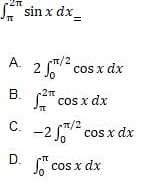PCAT Online Practice Questions and Answers
Questions 4
Which of the following will result if there is a drop-in blood pressure?
A. formation of glucose
B. secretion of insulin
C. secretion of EPO
D. secretion of ANP
Questions 5
The addition of HBr with peroxide and an alkene yields what product?
A. Markovnikov's product
B. anti-Markovnikov's product
C. Saytzeff's product
D. the ortho product
Questions 7
Which of the following species cannot hydrogen bond with itself?
A. ethanol
B. acetic acid
C. ammonia
D. acetone
Questions 8
Rank the following amino acids by increasing pI (isoelectric point):
I. Lys
II. Leu
III.
Asp
A.
I < II < III
B.
III < II < I
C.
II < I < III
D.
III < I < II
Questions 9
Sickle cell disease (SCD) affects millions of individuals worldwide, and the Sickle Cell Disease Association of America estimates that 70,000 to 100,000 individuals have SCD and 3 million individuals have the sickle cell trait. While SCD is known to primarily affect individuals of African American descent, individuals from South America, the Caribbean, Central America, the Middle East, and the Mediterranean can also have SCD or the SCD trait. SCD is estimated to affect 1 in 500 African American infants, and 1 in 12 African Americans are estimated to have the sickle cell trait. SCD is characterized by episodes of acute and chronic pain. By increasing awareness about SCD and promoting patient education, health care professionals can help patients and their families cope with SCD and better manage the associated pain. Recurring episodes of acute and/or severe pain are hallmarks of SCD. SCD pain can often be debilitating, and episodes of pain vary from patient to patient in both frequency and intensity. SCD pain can be classified as acute, chronic, or mixed. At some point, most SCD patients experience episodes of pain often referred to as vaso-occlusive crisis (sickle cell crisis), the duration of which may range from hours to days. Some patients seldom have a sickle cell crisis, while others may experience crises several times a year. Some episodes may be so severe that hospitalization is warranted to manage the pain. An acute pain event is the most common type of pain, and the onset is typically abrupt. It is often the result of an ischemic tissue injury, which is due to the occlusion of microvascular beds by sickled erythrocytes during an acute crisis. Acute pain episodes can also be triggered by factors including extreme temperature changes, changes in altitude, physical and emotional stress, illnesses, infections, dehydration, cold climates, menstruation, and fatigue. Chronic pain is pain that lasts for 3 to 6 months or longer. Chronic pain often results from the destruction of bones, joints, and visceral organs due to recurrent crises. Sources of chronic sickle cell pain include aseptic necrosis, leg ulcerations, and osteomyelitis. Unfortunately, acute and chronic pain associated with SCD are commonly undertreated or inappropriately managed due to patient fear of potential addiction and adverse effects. Many studies report that some health care professionals are also concerned about the potential for addiction. When appropriate, pharmacologic management of SCD pain may involve the use of 3 major pharmacologic classes: nonopioids, opioids, and adjuvants.
According to the passage, the major difference between acute pain and chronic pain is:
A. The severity of the pain involved
B. The duration of the pain involved
C. The side effects of the pain involved
D. The methods of managing the pain involved
Questions 10
Coughs that linger after a cold or sinus problem cause constant disruption in the home, school, and workplace. Often, these dry, nonproductive coughs become increasingly troublesome although other symptoms ?fever, congestion, and fatigue ?resolved days or weeks ago. This stubborn cough persists for weeks, and plagues its victim and the victim's family night and day. The diagnosis might be a common, but overlooked cause of lingering cough: atypical pneumonia caused by mycoplasma. Mycoplasma ? pleomorphic bacteria that lack a cell wall ?are the smallest and simplest self-replicating organisms known to humans. They probably evolved from gram-positive, walled eubacteria by degenerative evolution. Smaller than amoebas, these 0.1-micrometer organisms grow and reproduce slowly and require no oxygen or host cell. They also change shapes asymmetrically, appearing as long, thin filaments, tiny spheres, or branches. Scientists have identified more than 100 mycoplasma species. Fifteen species are known to live in humans, most as normal symbiotic flora. Mycoplasma pneumoniae, previously called "walking pneumonia," is pathogenic in humans. Mycoplasma pneumoniae glides freely and uses its specialized filamentous tips to burrow between cilia within the respiratory epithelium, causing the respiratory epithelial cells to slough. It also produces hydrogen peroxide, which causes initial cell disruption in the respiratory tract and damages erythrocyte membranes. Researchers have determined that more than 40% of infants younger than 1 year old have had a mycoplasma infection. By age 5, approximately 65% of children have been infected. Nearly all adults have been infected at least once, often repeatedly. Mycoplasma pneumonia usually affects people younger than 40 years of age. The highest incidence is found in the 5- to 9-year age group. The risk of contracting mycoplasma pneumonia is greatest for people who live or work in crowded areas, such as daycare facilities, schools, homeless shelters, long-term care units, and military and prison environments. However, many people who develop mycoplasma infections have no identifiable risk factor. Most mycoplasma infections cause mild to moderate clinical symptoms, but the infection incubates over 3 weeks and can last weeks without treatment. This infection cannot be diagnosed based on symptoms alone; laboratory testing is essential. Infection can also cause ear infections, sinus infections, bronchitis, croup, severe sore throats, infectious asthma, and 1 type of the common cold. When mycoplasma infects children, about 25% of them develop nausea, vomiting, or diarrhea.
The tone of the passage can best be described as:
A. contemptuous
B. judgmental
C. matter-of-fact
D. solemn





